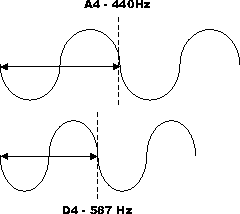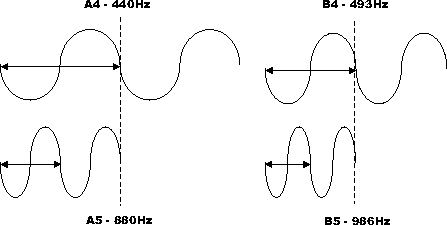

Once you have colored the pitch circle, imagine what it would look like if you unwound the spiral and laid all the pitches in order, in a musical scale. C, C#, D, Eb, E, F, F#... all the colors get all mixed up! That would look strange, wouldn't it? But that is the secret of lesson one: this is how a person with perfect pitch perceives the scales. All kinds of colors, all mixed up together.
Here are three colors. Which two are most alike?

Most likely you have chosen the two on the left-- light blue and regular blue-- because they are the same color. But you could also have chosen the two on the right-- regular blue and regular red-- because they are the same intensity.
Which two are most alike: low C, low D, and high C?
Normally we say that it's low C and low D, because they are the same octave. But the REAL answer is low C and high C, because they are the same pitch. A person with perfect pitch wrote this to me about how she hears pitches: "'Higher' is a construct. Pitches are not physically higher or lower." Just as same colors are more similar, same pitches are more similar.
If a piano played colors instead of pitches, its keyboard might look like this:
![]()
Do you see how the same pitch in each "octave" repeats the same color with a different intensity? The same thing happens on your instrument. In normal musical scales, pitches are mixed up together from "light" to "dark". Octaves are different shades of brightness. It has been scientifically demonstrated:
Marks, Hammeal, and Bornstein (1987) found that children as young as 4-5 years of age consistently matched the louder and higher-pitched of two sounds to the brighter of two lights (even though the youngest children did not yet understand the referent to the word "pitch"). This result is consistent with the hypothesis that the correspondences between loudness and brightness and between pitch and brightness are part and parcel of the make-up of the auditory and visual systems.
(Source: Synesthesia, L. Marks, 1999)
We may only be able to see one visible light spectrum, but in addition to "red" we see pink, light pink, dull red, and dark red. That's five "octaves" of red.
Scales were invented to explain how pitches function, relatively, within music. Your instrument's scale is an invention; it's an illusion. It's an arrangement of pitches based on relationships, not absolute pitch sounds. Scales have no bearing on pitches sounded outside of a piece of music. We are taught to listen to pitches within a scale, always hearing their relationships to other pitches. In learning perfect pitch, we're trying to recognize pitches by distinguishing the individual characteristics of the pitches regardless of how those pitches relate to other notes. Don't think of notes in different octaves as "higher" and "lower" than each other. Remember that they're the same pitches with different intensities.
Naturally I'm not saying that A is red or that any of these colors should be associated with pitches-- I'm merely illustrating a metaphor. You must understand that using color is analagous to pitch in this case; color is not pitch!
What is a pitch? It's a sound heard at a specific frequency. Our ear recognizes when the sine wave has finished its oscillating cycle, and that is how we know one pitch from another.

If you've studied music for any length of time, you know that the definition of an octave is a frequency ratio of 2 to 1. (and if you haven't studied music, you've just now learned that fact.) A4 is 440Hz, which means that A5 is 880 and A3 is 220.
But how do those look as sine waves? Here are four notes, two from each octave.

It's obvious that as you go up the musical scale, the frequency becomes larger (and the wave becomes narrower). However, it may not be so obvious that the two-to-one ratio of a perfect octave can be represented vertically, like this:

to show that pitches in different octaves, because the relationship of their wavelengths is precisely two to one, finish their oscillating cycle at the exact same time. All the As finish their cycle at the same time as each other. All the Bs finish their cycle at the same time as each other. All the Cs, and C-sharps, and E-flats-- each group of pitches ends concurrently. Each group of pitches has the same frequency cycle. Each group of pitches is the same pitch.
What we are learning in our perfect pitch training is how to perceive this pitch scale. We want to recognize that the same pitches, in different octaves, are "next to each other." So when you're learning perfect pitch, the important thing to remember is that the octaves and the intervals don't matter. G# is G# is G#, regardless of what octave it's in, and when you're singing notes for the exercises it doesn't matter if you sing the correct octave as long as you sing the correct note.